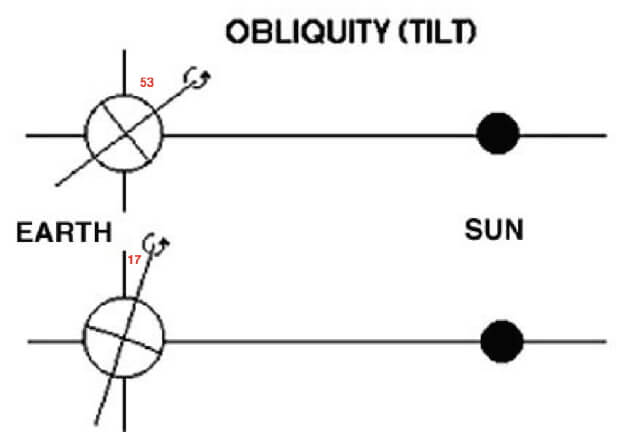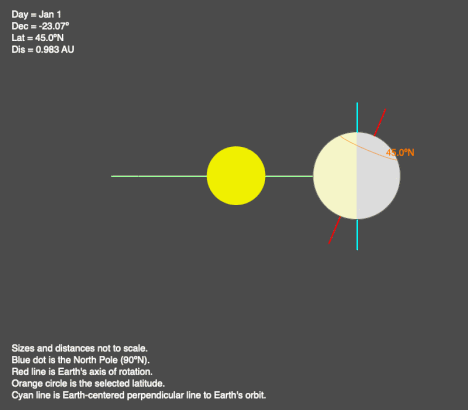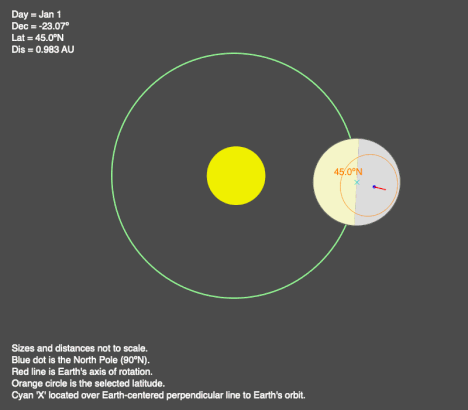Obliquity and Earth’s Illumination
Obliquity is the angle between the planes of the Earth’s equator and its orbit around the Sun. Another way to think about it is the angle of the Earth’s axis of rotation from the perpendicular to the orbital plane. Earth’s obliquity is 23.5º.
A solstice occurs when the Earth’s axis of rotation tilts toward the Sun, causing one hemisphere to be at peak illumination and the other to be minimally illuminated. An equinox occurs when both hemispheres are equally illuminated.
Earth is on average 93 million miles from the Sun, so the Sun’s rays are parallel to each other as they reach Earth. Therefore, the angle the sunlight hits the ground depends, in part, on the orientation of the horizon relative to the axis of rotation (see Earth’s Coordinate System for illustrations and the overview page of the Sun-Earth Connection for an interactive web app, the Sun and Your Horizon) and the orientation of the axis to the Sun.

Illustrations of an Earth with two obliquities: 53º (top) and 17º (bottom). The orbital plane is represented by the line that goes through the center of the Earth and the Sun. The axis of rotation is shown by the curve ending in an arrow.


In the two animations of Earth’s orbit (above), the axis of rotation stays oriented the same way throughout the orbit. Why does it do this?
Spinning objects have angular momentum (see Coriolis and Centrifugal Forces for details), which creates a resistance to changing its orientation of the axis of rotation. So Earth is one colossal gyroscope!
To feel this resistance, take the wheel off a bicycle or tricycle and add plastic handles extending from the axle. Holding the handles try changing the orientation of the tire when it isn’t rotating. Now, give the wheel a spin and try to change its orientation. Staying upright on a bike with the wheels spinning is much easier than when the wheels are not! Have you ever tried throwing a frisbee when you don’t spin it? Quite embarrassing!

Big Ideas
- Obliquity is the angle between the planes of the Earth’s equator and its orbit around the Sun. Another way to think about it is the angle of the Earth’s axis of rotation from the perpendicular to the plane of orbit. Earth’s obliquity is 23.5º.
- Earth’s obliquity creates seasonal cycles of uneven heating between the Northern Hemisphere and the Southern Hemisphere
Click on the following toggles to view descriptions and links of the web pages on each topic of the Sun-Earth Connection.
Sun-Earth Connection overview
An overview of how the Sun’s energy is generated and how its thermal radiation illuminates and heats Earth.
Earth Illumination Patterns
- Overview: The Sun illuminates the spherical, rotating planets orbiting it.
- Obliquity and Earth’s Illumination: Obliquity is the angle between the planes of the Earth’s equator and its orbit around the Sun.
- Declination, Latitude, & Earth Illumination: Solar declination is the angle between the Sun’s rays and the plane of the Earth’s Equator. Its value depends on where Earth is in its orbit around the Sun.
- Astronomical Seasons & Illumination: Astronomical seasons are based on the orientation of Earth’s axis of rotation to the Sun, which determines the amount of illumination between the Northern and Southern Hemispheres.
Distribution of the Sun's Energy on Earth
- Overview: Even though an area is illuminated by sunlight, there can be quite a range of energy interacting with the surface.
- Sun Angle and Beam Concentration: If every beam of sunlight reaching Earth has the same amount of energy, why do some areas warm up more than others?
- Diurnal Heating: Diurnal heating is the temperature change over 24 hours. When sunlight shines on the ground, it warms. Two critical factors that determine the amount of heating deal with the Sun’s illumination.
- Seasons: Earth experiences astronomical seasons due to its obliquity.
- Climate Regimes: Climate regimes are an extension of diurnal heating and seasons, but the time frame is now years.
Declination Circles: A tool to analyze the Sun's position in the sky.
- Overview: Drawings of declination circles contain the visual and numerical information to understand and predict the Sun’s motion across the sky.
- Declination Circles 101: Draw a declination circle with just a ruler and protractor/compass to quickly and accurately know the Sun’s position in the sky at any day and time of the year for any location on Earth.
- Drawing Declination Circles: Declination circles are quite easy to draw by hand.
- Interpreting Time on Declination Circles: Accurately estimate the time of day using the Sun’s location in the sky.
- Sunrise, Sunset, & Twilight: Calculate the timing and duration when the Sun is at or near the horizon.
- Solar Time, Angle, & Position: The sun’s angle and direction to the local horizon define the Sun’s position in the local sky. Explore how to use declination circles to calculate the Sun’s position at any solar time anywhere in the world on any day of the year.
- Changing Views of Declination Circles: Use the web app View Declination Circles to explore three common views of declination circles to identify their strengths, limitations, and applications. Then learn how to go from one view to another.
- Using Declination Circles: Humans have been using the apparent motion of the Sun as a compass, clock, and calendar for millennia.
- Using Sundials: Humans have been using the Sun’s position to navigate and tell the time, day, and season for millennia. Sundials create shadows that make it easier to do these tasks.

0 Comments